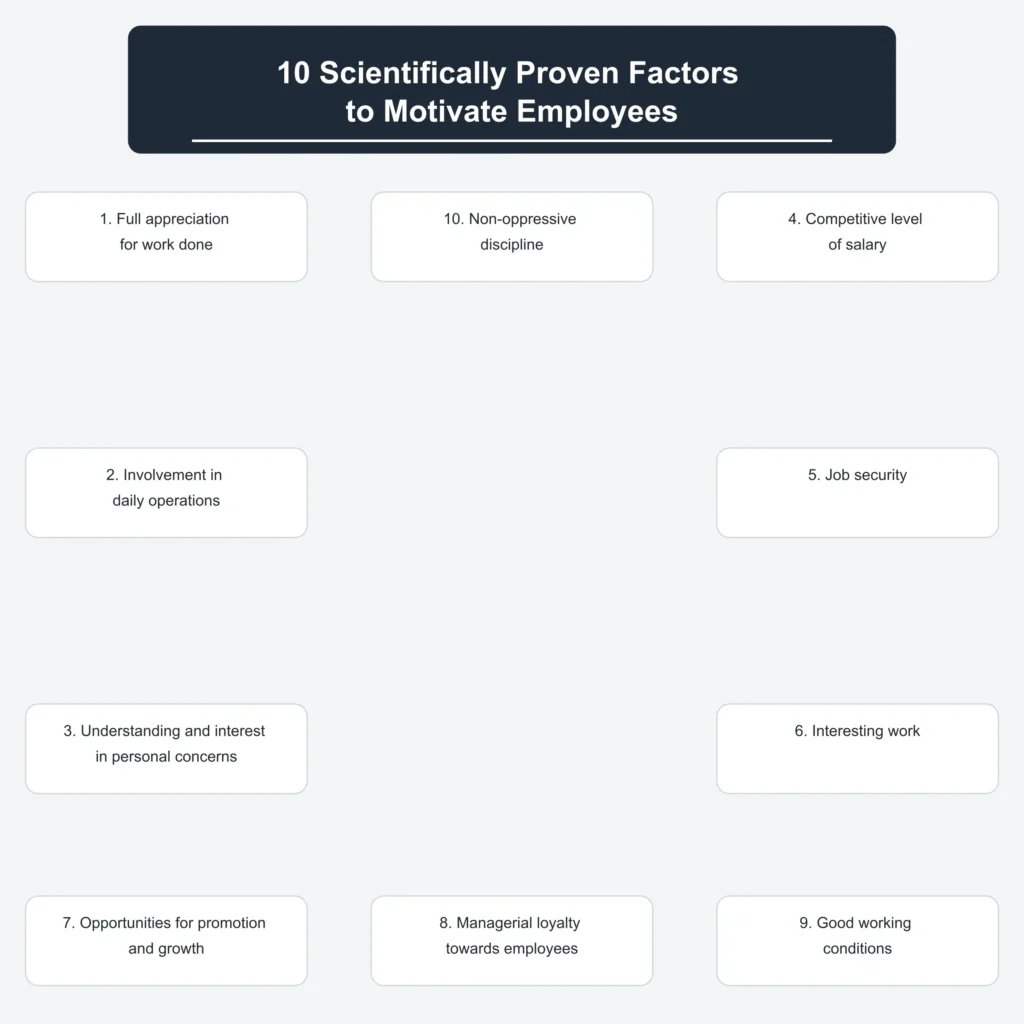Many companies invest time and money in training programs for their employees, but the results are often disappointing. This is often due to a disconnect between what entrepreneurs think will motivate their employees and what actually drives them to be productive.
This article presents a list of 10 scientifically proven factors to motivate employees and offers practical ideas to improve their productivity and create a positive work environment.

10 Scientifically Proven Factors to Motivate Employees
- Full appreciation for work done: Recognizing and valuing your employees’ efforts and achievements is paramount. Show them that you appreciate their work and that they are an essential part of the team.
- Involvement in daily operations: Employees want to feel engaged and involved in day-to-day operations and decision-making processes. Include them in discussions and seek their input on relevant topics.
- Understanding and interest in personal concerns: Show a genuine interest in your employees’ well-being, both professionally and personally. Offer support and assistance with their personal issues, fostering loyalty and motivation.
- Competitive level of salary: Competitive remuneration is essential to ensure employees feel fairly compensated for their work. Reward them justly and proportionally to their contribution.
- Job security: Provide a certain level of stability and job security to encourage employees to focus on their tasks without the fear of sudden termination.
- Interesting work: Employees are more likely to be motivated when they find their work stimulating and engaging. Ensure their tasks are varied and allow for learning and growth.
- Opportunities for promotion and growth within the company: Offer avenues for advancement and professional development within your organization to maintain your employees’ ambition and motivation.
- Managerial loyalty towards employees: Employees are motivated when they feel supported by their manager, who cares for their well-being. Demonstrate your commitment to helping them succeed.
- Good working conditions: A safe, comfortable, and well-equipped work environment is crucial for employee satisfaction and productivity. Invest in quality tools and resources.
- Non-oppressive discipline: Implement fair and reasonable disciplinary measures without being overly restrictive. This will contribute to a positive work atmosphere.
Putting These Motivational Factors into Practice
It is essential for managers and entrepreneurs to understand these factors and take steps to implement them within their teams. Failing to do so could lead to the “inverse motivation paradox,” where attempts at motivation may actually demotivate employees.
Read Also: 10 Objectives of Group Formation
Additionally, even with proper motivation, a small percentage of employees may remain unproductive. In such cases, consider reassigning them to less critical roles or, if necessary, terminating their contracts, as they can hinder overall productivity and team morale.
Daily Actions to Improve Productivity
To enhance productivity and create a positive work environment, incorporate these key actions into your daily practices:
- Offer sincere recognition for work accomplished.
- Show a genuine interest in your employees’ well-being.
- Involve them in company strategies.
- Encourage them for every improvement, no matter how small.
Finally, avoid spending too much time and effort on unproductive employees. It is preferable to minimize potential harm by reassigning or replacing them.
Read Also: Remote Work’s Evolution: Shaping the Future
Conclusion
By understanding and applying the true motivators of your employees, you can create a positive and stimulating work environment. This will not only improve productivity but also boost team morale and engagement.
FAQ
How can I ensure my employees feel involved in daily operations?
Organize regular meetings to discuss company goals, challenges, and successes. Solicit their ideas and suggestions, and involve them in decision-making when possible. Make sure they understand that their contribution is valued and that they are an integral part of the team.
Read Also: How To Improve team communication
What types of rewards can I offer to show my appreciation?
Rewards can vary depending on your budget and your employees’ preferences. They may include financial bonuses, gifts, recognition certificates, extra days off, or even a personalized thank-you card. Ensure that rewards are proportional to achievements and tailored to individual preferences.
How can I handle an employee who seems demotivated?
Read Also: Effective Communication Strategies in HR
Communicate openly with the employee to understand the underlying reasons for their lack of motivation. Offer support and work together to establish an action plan. This could involve changes in their tasks, training opportunities, or assistance in managing any personal issues affecting their motivation.
Remember that each employee is unique, and what motivates one person may not motivate another. As a manager, it is important to adapt your approach to the needs and preferences of each individual.
Read Also: Vroom’s Expectancy Theory: Explained


